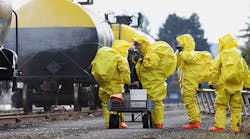The Emergency Planning and Community Right-to-Know Act (EPCRA) mandates that companies maintain hazardous chemical information to support state and local emergency planning and response for community awareness. EPCRA also requires reporting on the storage, use and release of hazardous chemicals to federal, state and local regulatory government agencies. In addition, facility site location maps must be kept up to date to reflect any changes in chemical storage location and types of storage, as well as providing updated reports for new hazardous chemicals above the reporting threshold to local fire departments and local and state emergency planning commissions.
Even with EPCRA having been the law of the land for 30 years, however, compliance experts regularly see many organizations that believe they are in compliance when they actually have lax policies and inadequate recordkeeping.
The reality is that failure to comply can have catastrophic results.
In April 2013, the West Fertilizer Co. (WFC) storage and distribution facility in West, Texas was destroyed as the result of an ammonium nitrate explosion, killing 15 (including 12 first responders) and injuring more than 160 others.
The WFC Final Report, issued January 2016, noted multiple violations of EPCRA, as well as violations of OSHA and EPA regulations such as including lack of fire detection systems and the improper reporting of the ammonium nitrate that caused the blast. These violations ultimately caused amplified physical damage to the facility and surrounding area, and also inhibited containment efforts following the initial disaster.
While complacency can lead to disastrous outcomes as it did in West, Texas, it also can lead to financial ruin for a company if it is fined for non-compliance or criminal negligence by the EPA.
Out of Compliance
Due to a number of factors, many facilities are in violation of at least one provision of EPCRA, usually without managers even realizing it.
For instance, the location of certain chemicals and materials can change over time, such as when the layout of a building changes or there are increases in capacity and equipment. Company turnover also can shift the responsibility of reporting these changes without anyone remembering to maintain the updated paperwork needed to meet compliance. Furthermore, new employees can inherit out-of-date spreadsheets or documentation, creating a “grandfathering” effect that allows inaccurate information to recirculate year after year.
In addition to maintaining the accuracy of current records, historical data also must be accurate, as companies are required to maintain a minimum of three years of documentation onsite. Failure to do so can result in fines by the EPA for up to 5 years after a violation (statute of limitations) including a fine of $37,500 per day if you fail to report. Typically, EPA has assessed the $37,500 per year/per chemical fine for EPCRA Toxics Release Inventory (TRI) violations. However, the agency can use discretion in the assessment of penalties, and the actual fine may be much more severe.
A Good Starting Point
EPCRA is complicated, but understanding these five sections is a good starting point:
- EPCRA Section 302 – Emergency Planning: Addresses notification to the state emergency response commission (SERC) and local emergency planning Committee (LEPC) of the presence, at any one time, of an extremely hazardous substance (EHS) in quantity > threshold planning quantity (TPQ), or 500 lbs., whichever is less.
- EPCRA Section 304 – Emergency Releases: Phone call and subsequent written notification when a facility releases an EHS in quantity > reportable quantity (RQ) OR a CERCLA hazardous substance in quantity > RQ.
- EPCRA Section 311 – Safety Data Sheets: A facility must submit OSHA hazardous chemical SDS or list of SDS to the SERC, LEPC and local fire department(s) for hazardous chemicals equal to or greater than 10,000 lbs., or EHS equal to or greater than 500 lbs. or the TPQ, whichever is less.
- EPCRA Section 312 - Tier II Inventory Reporting: A facility must submit a Tier II report by March 1 for the prior calendar year, to the SERC, LEPC and local fire department(s) for any storage/inventory – at any one time – of hazardous chemicals equal to or greater than 10,000 lbs. OR EHS equal to or greater than 500 lbs. or the TPQ, whichever is less.
- EPCRA Section 313 – Toxic Release Inventory Reporting (Form R/TRI): A facility must submit a TRI (Form R) report by meeting three key criteria: 1) Is a covered facility under a listed NAICS code, 2) Has 10 or more full-time employee equivalents (i.e. the total of 20,000 hours or greater); and 3) Manufacture or process any listed toxic chemical in excess of 25,000 lbs. during the course of a calendar year OR otherwise-use any listed toxic chemical in excess of 10,000 lbs. during the course of a calendar year.
Enforcement of these regulations has grown steadily more rigorous. Organizations need an exceptional level of attention to detail to properly mitigate potential risks and ensure full compliance. The margin for error is slim and the risks are real, and so I’d encourage you to make one of your 2017 New Year’s resolutions to ensure that your organization is taking every step and getting whatever support you need to protect itself.
About the author: Melissa Hart is the senior client services manager and market director for EHS management, engineering, construction & remediation at TRC Companies Inc. She has over 30 years of experience in private industry and consulting. Her environmental experience is focused on air pollution regulatory compliance, EPCRA/SARA compliance (including Tier II inventory, TRI reporting, auditing), due diligence, air permitting, civil penalty calculations & enforcement negotiation, and compliance with Homeland Security Chemical Facility Anti-Terrorism Standards (CFATS). She holds a BS in chemical engineering from the University of Missouri – Columbia.
